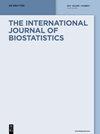Estimation of semi-Markov multi-state models: a comparison of the sojourn times and transition intensities approaches
IF 1.2
4区 数学
引用次数: 14
Abstract
Abstract Semi-Markov models are widely used for survival analysis and reliability analysis. In general, there are two competing parameterizations and each entails its own interpretation and inference properties. On the one hand, a semi-Markov process can be defined based on the distribution of sojourn times, often via hazard rates, together with transition probabilities of an embedded Markov chain. On the other hand, intensity transition functions may be used, often referred to as the hazard rates of the semi-Markov process. We summarize and contrast these two parameterizations both from a probabilistic and an inference perspective, and we highlight relationships between the two approaches. In general, the intensity transition based approach allows the likelihood to be split into likelihoods of two-state models having fewer parameters, allowing efficient computation and usage of many survival analysis tools. Nevertheless, in certain cases the sojourn time based approach is natural and has been exploited extensively in applications. In contrasting the two approaches and contemporary relevant R packages used for inference, we use two real datasets highlighting the probabilistic and inference properties of each approach. This analysis is accompanied by an R vignette.半马尔可夫多状态模型的估计:逗留时间和转移强度方法的比较
摘要半马尔可夫模型广泛用于生存分析和可靠性分析。一般来说,有两个相互竞争的参数化,每个参数化都有自己的解释和推理特性。一方面,半马尔可夫过程可以基于逗留时间的分布来定义,通常通过风险率,以及嵌入马尔可夫链的转移概率。另一方面,可以使用强度转移函数,通常称为半马尔可夫过程的风险率。我们从概率和推理的角度总结和比较了这两种参数化,并强调了两种方法之间的关系。通常,基于强度转换的方法允许将似然性划分为具有较少参数的两状态模型的似然性,从而允许高效计算和使用许多生存分析工具。然而,在某些情况下,基于逗留时间的方法是自然的,并且在应用中得到了广泛的利用。在对比这两种方法和用于推理的当代相关R包时,我们使用了两个真实数据集,突出了每种方法的概率和推理特性。此分析附有一个R小插曲。
本文章由计算机程序翻译,如有差异,请以英文原文为准。
求助全文
约1分钟内获得全文
求助全文
来源期刊

International Journal of Biostatistics
Mathematics-Statistics and Probability
CiteScore
2.30
自引率
8.30%
发文量
28
期刊介绍:
The International Journal of Biostatistics (IJB) seeks to publish new biostatistical models and methods, new statistical theory, as well as original applications of statistical methods, for important practical problems arising from the biological, medical, public health, and agricultural sciences with an emphasis on semiparametric methods. Given many alternatives to publish exist within biostatistics, IJB offers a place to publish for research in biostatistics focusing on modern methods, often based on machine-learning and other data-adaptive methodologies, as well as providing a unique reading experience that compels the author to be explicit about the statistical inference problem addressed by the paper. IJB is intended that the journal cover the entire range of biostatistics, from theoretical advances to relevant and sensible translations of a practical problem into a statistical framework. Electronic publication also allows for data and software code to be appended, and opens the door for reproducible research allowing readers to easily replicate analyses described in a paper. Both original research and review articles will be warmly received, as will articles applying sound statistical methods to practical problems.
 求助内容:
求助内容: 应助结果提醒方式:
应助结果提醒方式:


